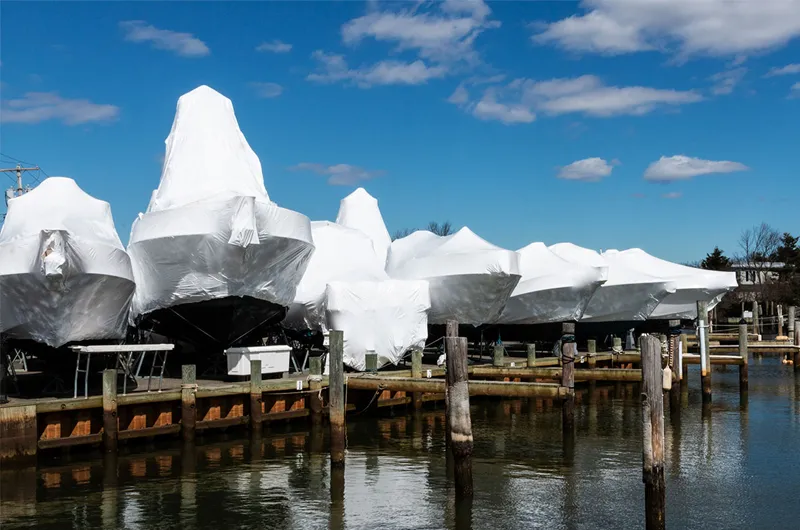
For some, the boating season may be winding down, and winterizing your boat is on your mind. For the more fortunate year-round boaters, a mid-season checkup for your boat should certainly be on the list.
This blog is a step-by-step guide on winterizing a boat, the needed tools, and products, as well as mid-season maintenance tips.
What Do You Need to Winterize a Boat?
Here are the essential tools and products a boat owner may need for winterization:
- Antifreeze
- Fogging oil
- Motor oil
- Fuel stabilizer
- Oil filter
- Lower-unit lube and drain plug gaskets
- Oil suction pump
- Lower-unit lube injection pump
How to Winterize a Boat – Important Steps to Take
Before undertaking any DIY winterization process, review and understand your manufacturer’s guides to ensure you are taking the correct steps for your specific boat and engine(s).
Here is a step-by-step guide on how to winterize your gasoline outboard engine-powered boat in preparation for winter.
1. Flush and Drain Water Lines
Water expands under extremely low winter temperatures causing damage. Be sure to drain water from the engine cooling systems, plumbing system, or any other system holding water. Flush the engine using water muffs until the engine reaches the optimum operating temperature.
2. Replace Engine Oil and Fluids
Different engines require different materials and methods to be fully winterized. Regardless, it’s essential to check your operator’s manual for the requirements.
- Change all fluids and filters as required. Ensure proper levels, including the oil, coolant, steering fluid, transmission/lower unit fluid, and outdrive oil.
- Inspect the fuel lines for any cracking and stiffness, and replace any line showing signs of wear and tear.
- Grease all the moving parts.
3. Stabilize Fuel
Fuel deteriorates in a short lifespan and causes the build-up of varnish and gum in the engine, resulting in hard starts, poor performance and reduced engine life.
- Top up the fuel tank with fresh fuel.
- Add a fuel stabilizer to prevent the build-up of varnish in the fuel lines, fuel injector, or carburetor.
- Ensure you run stabilized fuel through your engine.
4. Protect Internal Engine Components
During storage, engine oil drains away, potentially exposing internal engine components to scuffing and corrosion.
Use a fogging spray that coats internal engine components with a layer of anti-corrosive compound.
5. Remove Valuables
Remove any valuables and expensive electronics for safe storage.
Remember to insure your boat even if it will be out of action.
6. Clean and Wax
- Use a pressure washer as well as an acid-based hull or bottom cleaner if needed to remove fouling. It ensures you will have a clean surface during spring repainting.
- Thoroughly clean the cabin, heads, kitchen, and helm by scrubbing the topsides using a non-skid deck cleaner to remove dirt from the crevices. Then, clean all teak, plastic, glass, vinyl, and canvas.
- Apply a fresh coat of waterproofing to the canvas and wax the topsides of exposed fiberglass.
7. Safe Storage
After winterizing your boat, shrinkwrap it, use a canvas cover or place it in winter storage to shield it from the harsh weather as you wait for spring.
Mid-Season Maintenance Routine
If you are boating year-round, consider the following mid-season checkup tips. Be sure to review and understand your manufacturers’ guides to ensure you are taking the correct steps for your specific boat and engine(s).
Electrical Inspections
- Check and confirm that the batteries are fully charged.
- Clean the terminals and cable ends with a stiff wire brush and replace wing nuts with stainless steel lock nuts to prevent the cables from loosening up.
- Battery cables must be secured appropriately to the battery posts, so ensure the cover caps are still in place.
- Check all switches and knobs. Turn on lights, blow your horn, run the livewell, and wash down to ensure all controls are working.
- Check helm and cabin switches. Additionally, if you have an automatic bilge, ensure the pump float is working, along with the controller for manual operation (typically located at the helm).
Mechanical Inspections
Before any regular maintenance routine, always refer to the manufacturer’s operational manual.
- Check all engine fluid levels: oil, coolant, steering fluid, transmission/lower unit, and outdrive oil.
- Inspect the fuel lines for any cracking and stiffness, and replace any line showing signs of wear and tear.
- Grease all the moving parts.
- Turn the engine on and listen carefully for loose belts.
- Double-check hose connections and ensure the steering wheel turns freely and smoothly in all directions.
- Confirm your engine cut-off switch works by removing the lanyard to switch off the engine to prove the cut-off functionality, and then remove the key.
- Double-check all your safety gear to confirm their validity and functionality. These should include VHF radio, flares, fire extinguishers, boot hooks, lines, as well as first aid kits.
Unmatched member benefits
As the premier leader in on-water boating assistance, members receive the most comprehensive benefits available. Membership includes a full suite of on-water assistance services for every boat you own or rent. Learn more about our membership options today. To find the Sea Tow closest to you, use our service locator or call our Customer Care Team at 800-4-SEATOW.
